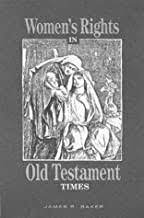Articles/Essays – Volume 27, No. 1
Women’s Rights | James R. Baker, Women’s Rights in Old Testament Times
The rights of women are a contested issue in religious communities which look to the Hebrew Bible, known as the Old Testament among Christians. A serious matter for these communities—Jewish, Christian, and Islamic—is how the Hebrew Bible understands the rights of women. Among Jews and Christians both defenders and opponents claim that the patriarchy of the book rightly or wrongly has promoted the diminishing of women’s rights and roles in society.
In this discussion, the relationship of the Old Testament’s understanding of the rights of women to that of its con temporary cultures is a very relevant issue. Some would argue that patriarchy is not a characteristic of the basic faith of the Bible but rather has been acquired during the history of Israel as it was lived among the cultures of the ancient Near East.
The author of Women’s Rights in Old Testament Times, James R. Baker, is a lawyer and approaches these issues through a careful knowledge of the legal codes of the ancient Near East. Twelve such “ancient legal documents” are identified, ranging in time from the Code of Ur-Nammu, ca. 2200 B.C., to “Jewish Law,” ca. A.D. 200-600. The next latter code is the Neo-Babylonian Laws of ca. 600 B.C.
Citing the authority of G. R. Driver and J. C. Miles, Baker asserts that “the law throughout the Fertile Crescent was for most practical purposes universal and the legal principles underlying the various codes were basically the same” (2). Having said this, the author gives a brief resume of the sources, background, and some characteristics of each of the legal documents which he uses.
A variety of Old Testament stories involving women are retold. Most of the stories are the Genesis accounts of the patriarchs of Israel, although the story of Ruth and of several of the women associated with King David are also presented. Discussion of these stories enables the reader to see that each in volves a context of legal practices, mostly involving the position of women in marriage and families. Various marriage arrangements are distinguished, such as metronymic, polygnous, and levirate; various aspects of the stories can be better understood through knowledge of these distinctions. The roles given to the women of the stories were often at least partially determined by the legal understanding of those roles in the communities of the ancient Near East. No stories of women outside the Old Testament are considered.
The texts which Baker uses represent both a variety of time periods as well as literary types. There is, however, no discussion of a methodology for analyzing such historical texts and literary types. Rather Baker seems to rely on retelling the story in the style of a con temporary storyteller who is free to add assumptions about motive, character, etc., and to use other material to fill in blanks. For example, details about the Genesis account of Jacob and Rachel are filled in from Josephus who wrote in the Common Era.
While Baker cites many scholars on a number of points, there is no aware ness of a considerable body of scholar ship having to do with the nature of the biblical texts themselves. Baker notes that “most modern scholars adhere to the documentary hypothesis of Julius Wellhausen” (12). It is difficult, however, to reconcile this statement with “the Hebrew Bible was written by scribes who lived at or near the times they were describing, whatever the historicity of any particular story” (ix). Moreover, there seems to be an assumption that all of the material is of the same literary type, whether it be the patriarchal stories of the Pentateuch, the later historical material regarding David, or the much later story of Ruth told within the conflicts of the post-exilic period. One does not need to accept the great body of biblical scholarship, but, one would think, any treatment of biblical texts should at least be aware of it.
There are a number of women in the pages of the Old Testament, and it would be difficult to consider them all. Nevertheless, Baker gives no reason for his selections. Is it that all of the women considered are dealt with in relation to men or to matrimonial matters? One wonders why such women as Miriam (Exodus 15) or Deborah the prophetess (Judges 5) who are much more stand alone figures were not also considered. One might also ask about the woman in the poems which make up the Song of Songs.
While the belief is expressed regarding the basic agreement of the various ancient codes, there is no discussion of the understanding of the rights of women in those codes. This would have been singularly useful, and the writer seems well prepared to have done so. Similarly, however, there is no real ana lytic discussion of those rights in the Old Testament. Rather the reader is given a kind of a commentary from the codes on some of the Old Testament material.
Stories in the Old Testament about women are given useful development in terms of their representation of the legal codes of the ancient Near East. This fact makes the book interesting and in some ways valuable. Nevertheless, the absence of any clear methodology for considering historical texts mitigates its usefulness for the serious student.
James R. Baker. Women’s Rights in Old Testament Times. Salt Lake City: Signature Books, 1992.


 Back to full Issue
Back to full Issue

